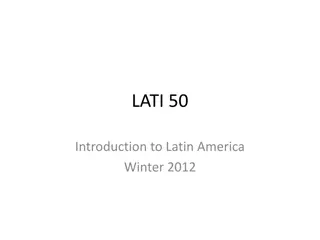Influence of African Slavery on Latin America's Development
African slavery played a significant role in the development of the Americas, particularly in Latin America. The transatlantic slave trade brought millions of Africans to the Americas to work in plantations, mines, and other industries. The triangular trade route facilitated the exchange of slaves for goods, generating profits for European traders. This forced labor system had a lasting impact on the economic, social, and cultural aspects of Latin American societies.
Download Presentation

Please find below an Image/Link to download the presentation.
The content on the website is provided AS IS for your information and personal use only. It may not be sold, licensed, or shared on other websites without obtaining consent from the author.If you encounter any issues during the download, it is possible that the publisher has removed the file from their server.
You are allowed to download the files provided on this website for personal or commercial use, subject to the condition that they are used lawfully. All files are the property of their respective owners.
The content on the website is provided AS IS for your information and personal use only. It may not be sold, licensed, or shared on other websites without obtaining consent from the author.
E N D
Presentation Transcript
SS6H1 - Explain conflict and change in Latin America. a. Describe the influence of African slavery on the development of the Americas.
Slavery With the rapid expansion of European influence into the New World , the need for a cheap and steadily available labor force to establish and maintain colonial industries and infrastructure particularly as relates to the cultivation and exportation of sugarcane and coffee was crucial. Spanish and Portuguese landowners at first sought such a labor force among the conquered indigenous populations of Latin America; however, the arrival of Europeans in the New World brought with it a number of virulent diseases (e.g., smallpox) which decimated native populations.
Transatlantic Slave Trade The Spanish and Portuguese began importing slave labor from West Africa in what became known as the transatlantic slave trade. Sanitation and living conditions on the many slave ships, which brought black Africans to the Americas, were deplorable; the mortality rate on such journeys was typically 25%. This black African slave labor force was impressed into agricultural work on plantations and haciendas throughout Latin America, as well as in gold and diamond mines in Brazil.
How Slaves were placed on the ships
The Triangular Trade The slave trade began with Portuguese (and some Spanish) traders, taking mainly West African (but some Central African) slaves to the American colonies they had conquered in the 15th century. British sailors became involved in the trade in the 16th century and their involvement increased in the 18th century when the Treaty of Utrecht (1713) gave them the right to sell slaves in the Spanish Empire. The slave trade made a great deal of profit for those who sold and exchanged slaves. Therefore, they often ignored the fact it was inhuman and unfair.
At least 12 million Africans were taken to the Americas as slaves between 1532 and 1832 and at least a third of them in British ships. For the British slave traders it was a three-legged journey called the 'triangular trade': West African slaves were exchanged for trade goods such as brandy and guns. Slaves were then taken via the Middle Passage across the Atlantic for sale in the West Indies and North America. Finally, a cargo of rum and sugar taken from the colonies, was taken back to England to sell.























